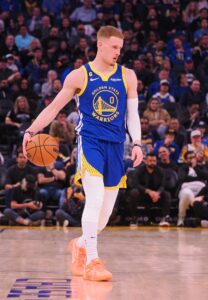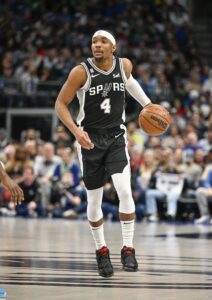For NBA teams looking to open up cap room, simply waiving a player isn’t as effective as it is in the NFL, where salaries are often non-guaranteed and most or all of a player’s cap charge can frequently be wiped from a team’s books. Still, the NBA’s Collective Bargaining Agreement does feature a rule that allows teams to spread a player’s cap hit over multiple seasons. This is called the stretch provision.
The stretch provision ensures that any player waived with at least $250K in guaranteed salary remaining on his contract will have the payment schedule of that money spread across multiple years. That schedule is determined as follows:
- If a player is waived between July 1 and August 31, his remaining salary is paid over twice the number of years remaining on his contract, plus one.
- If a player is waived between September 1 and June 30, his current-year salary is paid on its normal schedule, with any subsequent years spread over twice the number of remaining years, plus one.
- If a player in the final year of his contract is waived between September 1 and June 30, the stretch provision does not apply.
While the new payment schedule for a waived player is non-negotiable, teams get to decide whether or not to apply the stretch provision to that player’s cap charges as well. A team can stick to the original schedule for cap hit purposes, if it so chooses.
Rather than singling out a specific active player, we’ll use a hypothetical contract to create a clearer picture of what these rules look like. Let’s say there’s a player earning $19MM this season, $20MM in 2023/24, and $21MM in ’24/25 who has become a candidate to be waived.
Here’s what that contract would look like if it were waived without applying the stretch provision to the cap hits; if it were stretched before August 31; or if it were stretched after August 31:
| Year | Waived without stretching |
Stretched by 8/31/23 |
Stretched after 8/31/23 |
|---|---|---|---|
| 2022/23 | $19,000,000 | $19,000,000 | $19,000,000 |
| 2023/24 | $20,000,000 | $8,200,000 | $20,000,000 |
| 2024/25 | $21,000,000 | $8,200,000 | $7,000,000 |
| 2025/26 | – | $8,200,000 | $7,000,000 |
| 2026/27 | – | $8,200,000 | $7,000,000 |
| 2027/28 | – | $8,200,000 | – |
Because this hypothetical player wasn’t waived and stretched before August 31, 2022, his salary for the current year can no longer be stretched. Stretching his contract last July or August would have resulted in cap hits of about $8.57MM spread across seven seasons (through 2028/29 and including ’22/23).
As this chart shows, it typically makes sense to waive and stretch a player’s contract in July or August if the team is looking to generate immediate cap flexibility for the current season and isn’t as concerned about the impact in future seasons. If this hypothetical player were stretched in July 2023, his team would trim nearly $12MM off its ’23/24 cap, but would remain on the hook for payments through 2028.
 We saw a couple real-life examples of this philosophy at play last summer, when the Trail Blazers waived and stretched Eric Bledsoe and Didi Louzada and the Pacers waived and stretched Nik Stauskas, Juwan Morgan, and Malik Fitts.
We saw a couple real-life examples of this philosophy at play last summer, when the Trail Blazers waived and stretched Eric Bledsoe and Didi Louzada and the Pacers waived and stretched Nik Stauskas, Juwan Morgan, and Malik Fitts.
Portland was looking to reduce its team salary for the current year in order to sneak below the luxury tax line, while Indiana wanted to carve out a little extra cap room in order to sign Deandre Ayton to a maximum-salary offer sheet.
In each of those cases, the club sought immediate cap relief. That wasn’t the case for the Spurs, who waived Danilo Gallinari last July and decided not to apply the stretch provision to his $13MM cap charge for 2022/23, since they had no specific use for that extra cap room. It made more sense for San Antonio to take the hit this season and keep Gallinari’s money off their future cap sheets.
There are a couple more key rules related to the stretch provision worth noting.
First, while the stretch provision regulates when money is paid out, it doesn’t prevent teams and players from negotiating a reduced salary as part of a buyout agreement.
For example, let’s say a player who has an $18MM expiring contract for 2023/24 agrees this July to give up $3MM in a buyout. As a result of that buyout agreement, his team could stretch his remaining salary and end up with cap hits of $5MM for three seasons (through ’25/26) rather than $6MM.
Second, non-guaranteed money isn’t subject to the stretch provision, since a team isn’t obligated to pay the non-guaranteed portion of a contract once it waives a player.
This rule can come in handy when a club decides to waive a player who has one or two non-guaranteed years tacked onto the end of his contract. For instance, when the Blazers waived Louzada last August, he had three years left on his deal, but only his 2022/23 salary of $1,876,222 was guaranteed — the $4,023,212 owed to him for the two seasons beyond this one was fully non-guaranteed.
That means that when they waived Louzada, the Blazers only owed him just $1,876,222 but were able to stretch that figure across seven seasons (twice the three years remaining on his contract, plus one). As a result, Portland will carry tiny $268,032 cap charges for Louzada on its books through the 2028/29 season.
Note: This is a Hoops Rumors Glossary entry. Our glossary posts will explain specific rules relating to trades, free agency, or other aspects of the NBA’s Collective Bargaining Agreement. Larry Coon’s Salary Cap FAQ was used in the creation of this post.
Earlier version of this post were published in 2013 and 2017.

 After going undrafted out of Oklahoma in 2021, Reaves initially caught on with the Lakers on a two-way deal, but received a promotion to a standard contract before his rookie season started. He was one of the bright spots in an otherwise disappointing season in Los Angeles, averaging 7.3 PPG, 3.2 RPG and 1.8 APG on .459/.317/.839 shooting (.600 true shooting percentage) in 61 games (23.2 MPG).
After going undrafted out of Oklahoma in 2021, Reaves initially caught on with the Lakers on a two-way deal, but received a promotion to a standard contract before his rookie season started. He was one of the bright spots in an otherwise disappointing season in Los Angeles, averaging 7.3 PPG, 3.2 RPG and 1.8 APG on .459/.317/.839 shooting (.600 true shooting percentage) in 61 games (23.2 MPG). I was very surprised at how relatively little money DiVincenzo received in his first free agency foray last summer. I know he was coming off a down season in ’21/22 following left ankle surgery and had particularly struggled with his shot – he posted a .351/.339/.843 shooting line in 42 combined games (24.0 MPG) with Milwaukee and Sacramento (.510 TS%).
I was very surprised at how relatively little money DiVincenzo received in his first free agency foray last summer. I know he was coming off a down season in ’21/22 following left ankle surgery and had particularly struggled with his shot – he posted a .351/.339/.843 shooting line in 42 combined games (24.0 MPG) with Milwaukee and Sacramento (.510 TS%). Okogie spent his first four seasons with Minnesota, the team that drafted him 20th overall in 2018. They let him walk after his rookie deal expired, and the 24-year-old was only able to find a veteran’s minimum deal with Phoenix.
Okogie spent his first four seasons with Minnesota, the team that drafted him 20th overall in 2018. They let him walk after his rookie deal expired, and the 24-year-old was only able to find a veteran’s minimum deal with Phoenix. Multiple
Multiple While Kennard has remained a highly efficient three-point shooter with the Clippers in ’22/23, he battled a calf strain that sidelined him for significant stretches – he only appeared in 35 of 58 games. He also wasn’t a major part of the team’s playoff rotation a couple years ago and can be frustratingly passive on offense considering he’s a minus on the defensive end – it’s bizarre to see a 44.9% three-point shooter not be more aggressive looking for his shot.
While Kennard has remained a highly efficient three-point shooter with the Clippers in ’22/23, he battled a calf strain that sidelined him for significant stretches – he only appeared in 35 of 58 games. He also wasn’t a major part of the team’s playoff rotation a couple years ago and can be frustratingly passive on offense considering he’s a minus on the defensive end – it’s bizarre to see a 44.9% three-point shooter not be more aggressive looking for his shot. Kennard, on the other hand, is only 26 years old, nine years younger than Green. He brings a much-needed skill to the Grizzlies, who rank just 25th in the league in three-point percentage (34.3%).
Kennard, on the other hand, is only 26 years old, nine years younger than Green. He brings a much-needed skill to the Grizzlies, who rank just 25th in the league in three-point percentage (34.3%). Shedding Graham’s salary over the next couple of seasons — he’s owed $12.1MM in ‘23/24 and a partially guaranteed $2.85MM ($12.65MM base) in ‘24/25 — likely cost the Pelicans at least two second-round picks, if not three. Replacing him with Richardson for an extra second or two was a low-risk maneuver.
Shedding Graham’s salary over the next couple of seasons — he’s owed $12.1MM in ‘23/24 and a partially guaranteed $2.85MM ($12.65MM base) in ‘24/25 — likely cost the Pelicans at least two second-round picks, if not three. Replacing him with Richardson for an extra second or two was a low-risk maneuver. While Graham was redundant on the Pelicans, the Spurs had a glaring need at point guard –
While Graham was redundant on the Pelicans, the Spurs had a glaring need at point guard –  Harden started to look a little old and out of shape in 2021/22, never quite recovering from a reoccurring hamstring injury originally sustained in late ‘20/21.
Harden started to look a little old and out of shape in 2021/22, never quite recovering from a reoccurring hamstring injury originally sustained in late ‘20/21. Acquired in a deadline deal with San Antonio, Poeltl has gotten off to a great start in his second stint with Toronto, looking very motivated in averaging 14.9 PPG, 9.2 RPG, 2.5 APG, 1.8 SPG and 1.7 BPG while shooting 69% from the floor and 56.1% from the free throw line through 12 games (28.4 MPG).
Acquired in a deadline deal with San Antonio, Poeltl has gotten off to a great start in his second stint with Toronto, looking very motivated in averaging 14.9 PPG, 9.2 RPG, 2.5 APG, 1.8 SPG and 1.7 BPG while shooting 69% from the floor and 56.1% from the free throw line through 12 games (28.4 MPG).